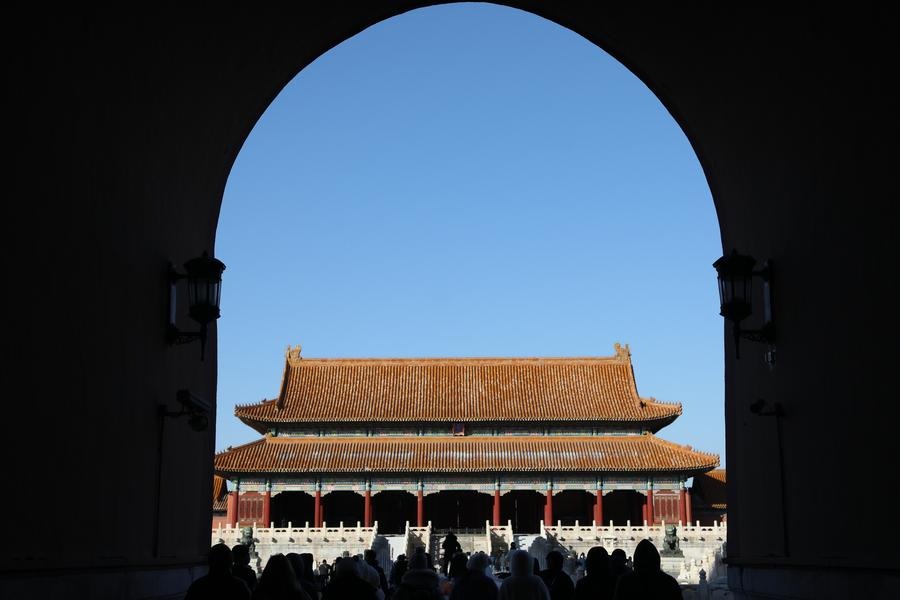Beneath the Golden Dome: The quiet march toward space weaponization

Editor's note: US President Donald Trump approved the design of the $175-billion "Golden Dome" missile defense shield program on Tuesday. The system aims to build a satellite network to guard against "missile threats" from China and Russia. Experts share their views on the Golden Dome and its feasibility and legitimacy with China Daily's Pan Yixuan and Li Huixian. Excerpts follow:
Space militarization making the final frontier more dangerous
In the 1980s, the then US president Ronald Reagan launched the "Star Wars"?program?—?a bold vision to deploy space-based systems capable of intercepting incoming nuclear missiles. At the time, the plan was shelved,?largely because of the astronomical costs and technological limitations. Four decades later, a strikingly similar idea has returned in?the form?of the "Golden Dome",?a new generation of missile defense architecture that leverages thousands of low-orbit satellites to form a global shield. But while this iteration may seem?more achievable, its strategic, financial, and geopolitical implications raise significant concerns.
What has changed is not the ambition, but the technological and economic landscape. With companies such?as?SpaceX?revolutionizing reusable rocket technology, the cost of launching satellites has plummeted. Instead of launching?a few satellites at exorbitant costs, today's launch vehicles can send up to 50-60?satellites?at?one go, enabling the deployment of satellite constellations numbering in the tens of thousands. In that?sense, the "Golden Dome"?is no longer a fantasy.
However, feasibility does not equate to?responsibility. The first issue is orbital congestion. Already, astronomers and space agencies have voiced serious concerns about the growing traffic in low-Earth orbit, affecting everything from telescopic observations to the risk of catastrophic collisions. The Golden Dome would dramatically intensify this problem?—?dominating orbital real estate, crowding out other nations'?satellites, and heightening the risk of space debris.
Second, the system raises strategic red flags. Despite US assurances that it does not violate the Outer Space Treaty?—?according?to which?outer space should?be free for exploration and use by all states?— the deployment of thousands of potentially weaponized satellites effectively militarizes space. Washington may argue that these are "defensive"?measures,?but the distinction is murky. Once operational, such a system could undermine nuclear deterrence by giving the United States?a perceived first-strike advantage, destabilizing long-standing strategic balances with nuclear-armed states such as?Russia, China, and the Democratic People's Republic of?Korea.
Finally, the Golden Dome may serve as a geopolitical lever, pressuring allies to join a US-led "space shield"?and isolating those who resist. This could accelerate a dangerous arms race in orbit, as other nations scramble to counter or replicate the technology.
In reviving a Cold War relic with modern tools, the US risks turning space from a shared domain of exploration into a theater of confrontation. The Golden Dome may gleam above, but beneath it lies a deep and unsettling shadow.
Hao Tian, a senior military commentator.
Don't get drawn into a US-stirred arms race
There is no need to exaggerate the US' Golden Dome system plan as a 2.0 version of the "Star Wars" program that was proposed in the 1980s by former US president Ronald Reagan.
The weaponization of space is a long-standing?concept that has come close to being realized with the development of technology. The development of sea-based, land-based, air-based, and space-based missiles, especially hypersonic missiles, has created a challenge for all countries ?— how they can establish an effective missile defense system.?The United States, which is keen to maintain its absolute military advantage, is unlikely to overlook this trend.
Though the Golden Dome program will cost a lot, $175 billion in total or $25 billion at the start of next year is not a huge sum in terms of the arms race, considering that military spending by the US was $997 billion in 2024 and manufacturing a single B-2 Spirit stealth bomber costs about $2 billion. Maintaining military personnel and equipment also requires substantial investment.
Technological progress has led to the improvement of operational styles, operational concepts, and armament. The Golden Dome is more like a natural outcome of the US government upgrading its understanding of future warfare and defense systems.
To be honest, a global arms race has started and accelerated since Russia and Ukraine entered a prolonged military conflict, not to mention risks in the Gaza Strip, Iran, Yemen, etc. The sense of security has declined worldwide in recent years. Countries with the ability to develop high-tech defense systems are continuing their efforts. The key to peace lies in avoiding getting affected and drawn into an insane spiral of vicious military competition.
Besides, the Pentagon tends to promote alarmist narratives about US security risks, including the so-called China threat, to justify greater fiscal appropriations. For the US, the arms trade prospers with increasing conflicts and an intensifying arms race.
Keeping a balance between economic development and defense development, as well as maintaining a rational pace, is important not only for China but also for other countries.
Liu Qiang, director of the Academic Council and a senior research fellow at the Shanghai Center for RimPac Strategic and International Studies.
If you have a specific expertise, or would like to share your thought about our stories, then send us your writings at opinion@chinadaily.com.cn, and comment@chinadaily.com.cn.
?


































